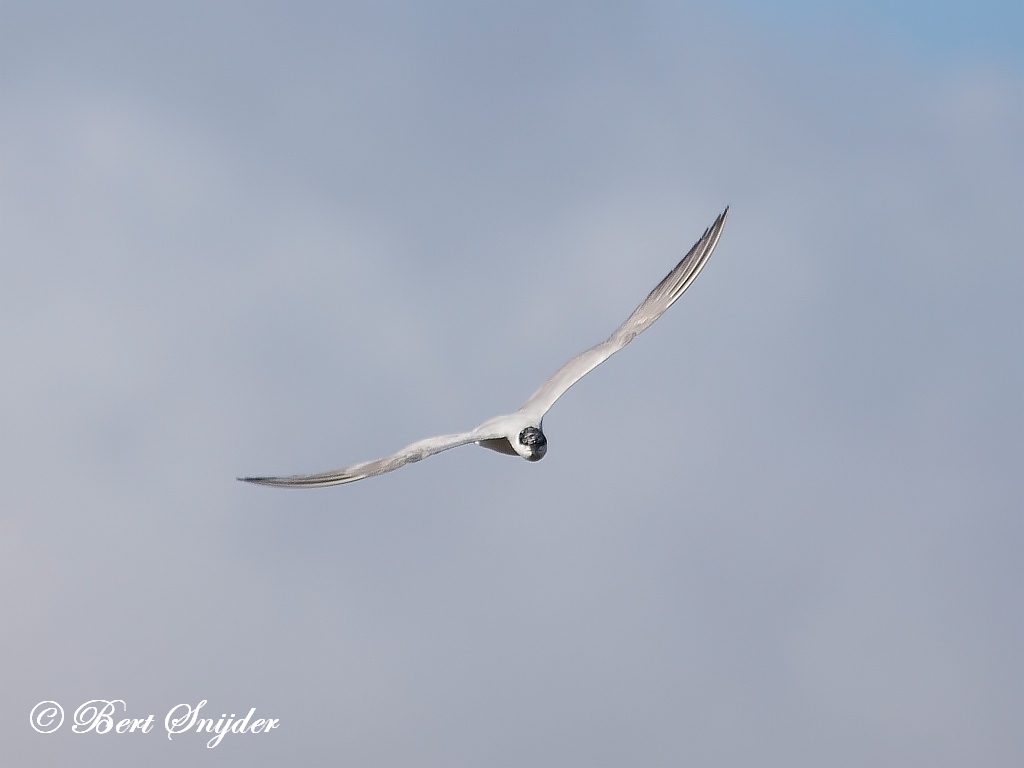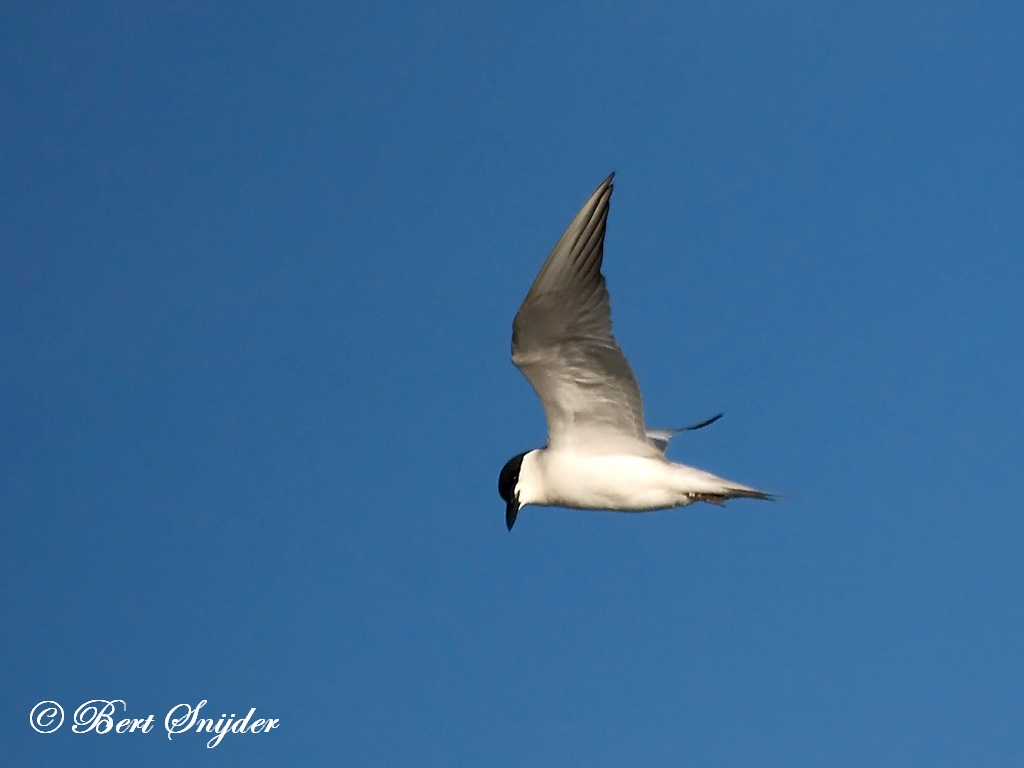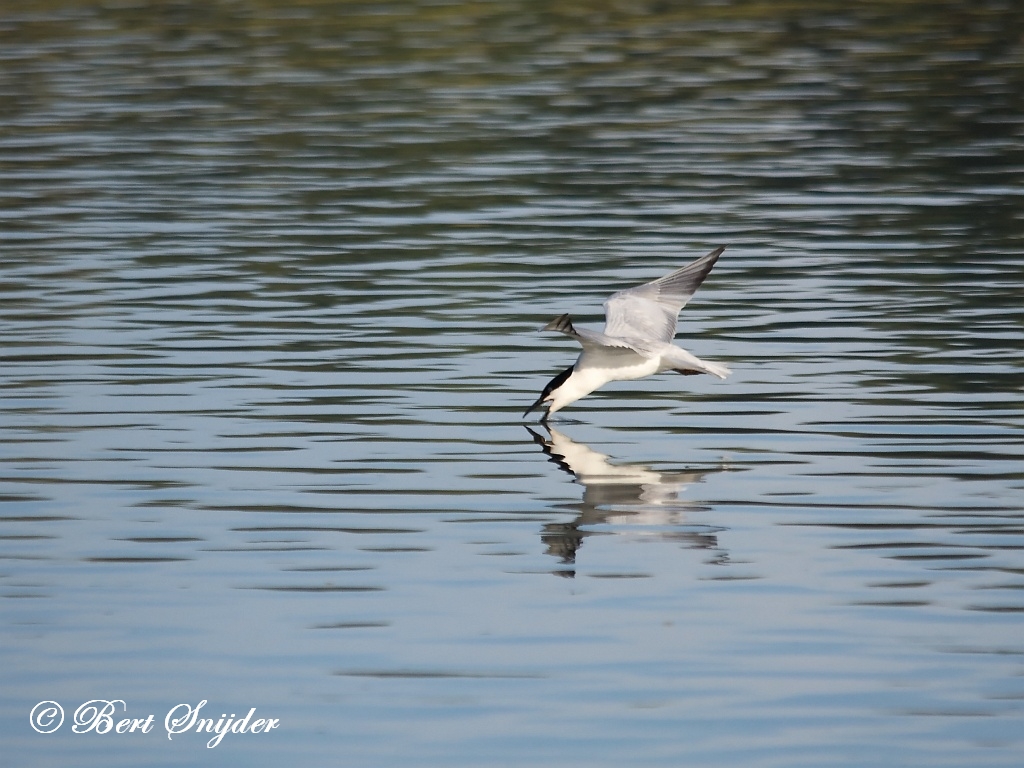Gull-billed Tern, Lachstern, Lachseeschwalbe, Gaivina-de-bico-preto, Pagaza Piconegra
Spotted in the Alentejo region of Portugal. Gull-billed Tern sound
The Gull-billed Tern (Gelochelidon nilotica), is a seabird of the tern family Sternidae. It is now considered to be in its own genus.

More photos at the bottom of this page:
This is a fairly large and powerful tern, similar in size and general appearance to a Sandwich Tern, but the short thick gull-like bill, broad wings, long legs and robust body are distinctive. The summer adult has grey upperparts, white underparts, a black cap, strong black bill and black legs. The call is a characteristic ker-wik. It is 33–42 cm (13–17 in) in length and 76–91 cm (30–36 in) in wingspan. Body mass ranges from 150–292 g (5.3–10.3 oz).
In winter, the cap is lost, and there is a dark patch through the eye like a Forster’s Tern or a Mediterranean Gull. Juvenile Gull-billed Terns have a fainter mask, but otherwise look much like winter adults.
Juvenile Sandwich Terns have a short bill, and are frequently mistaken for Gull-billed Tern where the latter species is uncommon, such as North Sea coasts.
It breeds in warmer parts of the world in southern Europe (and a very small isolated population in northern Germany and Denmark), temperate and eastern Asia, both coasts of North America, eastern South America and Australia. This bird has a number of geographical races, differing mainly in size and minor plumage details.
All forms show a post-breeding dispersal, but the northern breeders are most migratory, wintering south to Africa, the Caribbean and northern South America, southern Asia and New Zealand.
The Gull-billed Tern is one of the species to which the Agreement on the Conservation of African-Eurasian Migratory Waterbirds (AEWA) applies.
This species breeds in colonies on lakes, marshes and coasts. It nests in a ground scrape and lays two to five eggs. While widely distributed in freshwater areas in Eurasia, it is associated almost solely with saltwater, coastal areas in North America.
This is a somewhat atypical tern, in appearance like a Sterna tern, but with feeding habits more like the Chlidonias marsh terns, Black Tern and White-winged Tern. It used to be grouped in the genus Sterna but is now placed on its own in the genus Gelochelidon.
The Gull-billed Tern does not normally plunge dive for fish like the other white terns, and has a broader diet than most other terns. It largely feeds on insects taken in flight, and also often hunts over wet fields and even in brushy areas, to take amphibians and small mammals, as well as small birds and the chicks and eggs of other terns. It is also an opportunistic feeder, and has been observed to pickup and feed on dead dragonflies from the road.




Other synonyms:
Asturian: Escribana Beriza, Mederizu Montesín
Afrikaans: Oostelike Seeswael , Oostelike Sterretjie
Asturian: Chirri Picuprietu
Breton: Ar skrav beg tev
Catalan: Curroc, Llambritja de bec negre
Catalan (Balears): Llambritja de bec negre
Czech: Rybák cernozobý, Rybák ?ernozobý, rybák èernozobý
Welsh: Morwennol ylfinbraff
Danish: Sandterne
German: Lachseeschwalbe, Lachsseeschwalbe, Lachsseeschwalbe-nilotica
Maldivian: Kanifulhu Dhooni
English: Gullbilled Tern, Gull-billed Tern, Marsh Tern
Spanish: Charrán Pico Grueso, charrán picogrueso, Charrán Piquigordo, Charrán piquinegro, Gaviota de Pico Corto, Gaviota Pico Corto, Gaviota Piquigorda, Gaviotín Blanco, Gaviotín de Pico Negro, Gaviotín pico grueso, Gaviotín Pico Negro, Golondrina-marina Piquigruesa, Pagaza Piconegra
Spanish (Argentine): Gaviotín pico grueso
Spanish (Chile): Gaviotín pico grueso
Spanish (Colombia): Gaviotín Blanco
Spanish (Costa Rica): Charrán piquinegro
Spanish (Cuba): Gaviota de Pico Corto
Spanish (Dominican Rep.): Charrán Piquigrueso, Gaviota Pico Corto
Spanish (Mexico): charrán pico grueso, charrán picogrueso, Golondrina-marina Piquigruesa
Spanish (Nicaragua): Charrán Piquinegro
Spanish (Paraguay): Gaviotín pico grueso
Spanish (Uruguay): Gaviotín Pico Grueso, Gaviotín Pico Negro
Spanish (Venezuela): Gaviota Pico Gordo
Estonian: naerutiir
Basque: Curroc, Txenada mokobeltza
Finnish: Hietatiira
Faroese: Sandterna
French: Sterne à gros bec, Sterne hansel
Irish: Geabhróg Ghobdhubh
Galician: Carrán de bico curto, Curroc
Guarani: Atî
Haitian Creole French: Fou bèk nwa
Hindi: Kadal kuruvi
Croatian: Debelokljuna Cigra, Debelokljuna ?igra
Hungarian: Kacagócsér
Indonesian: Dara laut paruh hitam, Daralaut Tiram
Icelandic: Sandþerna
Italian: Sterna zampenere
Japanese: hashibutoajisashi, Hashibuto-ajisashi
Latin: Gelochelidon nilotica, Gelochelidon nilotica nilotica, Geochelidon nilotica, Sterna angelica, Sterna nilotica
Malay: Camar Tiram
Dutch: Lachstern
Norwegian: Sandterne
Polish: Mewa trójpalczasta, rybitwa krótkodzioba
Portuguese: gaivina de bico preto, Gaivina-de-bico-preto, Trinta-réis-de-bico-preto
Portuguese (Brazil): Trinta-réis-de-bico-preto
Romansh: Pestgarel chomma naira
Slovak: rybár krátkozobý, rybár krátkozobý (rybárka krátkozobá), Rybárka krátkozobá
Slovenian: crnonoga cigra
Albanian: Dallëndyshe deti këmbëzezë
Serbian: debelokljuna cigra
Swedish: Sandtärna
Swahili: Shakwe Domo-nene
Travel Birdwatching Holiday Alentejo, Vacation Portugal for birders guided birdwatching Tours and Trips.